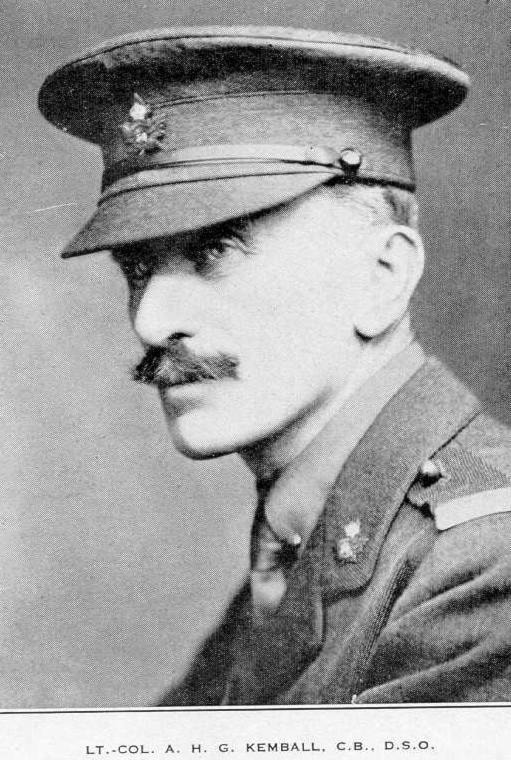Most Trail residents know the Canadian Forces armoury in Shavers Bench as a military place, that trains reserves, stores equipment; where the cadets meet, the Trail Pipe Band practices and a place that used to host the ski swap.
But perhaps few know the details of the man for which the armoury is named.
In May 2000, the Trail armoury was officially renamed the Lieutenant Colonel Arnold Henry Grant Kemball, CB, DSO Armoury.
LCol Kemball died 100 years ago, on March 1, 1917, but his legacy lives on as a role model for the young men and women who walk through the doors of the Trail hall.
Born in India in 1861, the son of Major General J.S. Kemball of England, the young Kemball followed his father’s footsteps into the military. By 1907 he was promoted to rank of Colonel and commanded the 5th Gurkha Rifle Regiment of the Indian Army until his retirement in 1910.
“In 1911, a retired veteran of the Indian Wars, Lt. Col. A. H. G. Kemball, relocated his family from the United Kingdom to the shores of Kootenay Lake at Kaslo. A more relaxed and idyllic life of fruit farming was his dream, however it was not meant to be for this quiet hero,” wrote Trail Times contributor Patricia A. Rogers.
“When war was proclaimed, Kemball answered the call and was placed in command of the newly-formed 54th Kootenay Battalion. His strength of spirit, discipline and leadership combined with the loyalty and determination of his troops resulted in the formation of a superb fighting unit.”
They arrived in France in August, 1916 and became part of the Fourth Division and saw action in the major theatres of the European Front.
“The men of the 54th experienced trench warfare at its worst, the evils of barbed wire, the first use of poisonous gas and the awesome sight of Baron Manfred von Richthofen and his “Flying Circus” soaring overhead,” wrote Rogers.
“These young men saw more in three years than most in a lifetime. Many never returned to their homes and remain interred on European soil.”
On Nov. 18, 1916 LCol Kemball led the 54th Kootenay Battalion in the highly successful attack on Desire Trench. For his leadership he was awarded the Distinguished Service Order (DSO). After the battle at Desire Trench, the battalion marched north to the Vimy Front to join the rest of the Canadian forces.
In late February, the Kootenay Battalion was ordered to carry out a large trench raid. A plaque in the Kemball Armoury detailed his final days in battle.
“This raid was to be carried out with gas instead of the customary artillery barrage,” it described. “On March 1, 1917 Lieutenant Colonel Kemball , foreseeing that the raid had little chance of success, defied orders and personally led two companies engaged in the raid. The companies lost direction in the poor visibility and he moved to lead the left-hand company on the proper bearing. While trying to find a gap in the wire he was killed by German fire.”
Of the 405 soldiers participating in the raid over 200 were casualties.
“On March 3 (1917), a temporary truce to recover the fallen was arranged. Recognizing Lieutenant Colonel Kemball’s devotion to duty, the Germans returned his body with great respect.”
Col. Kemball was buried at Villers Station Cemetery within sight of the Vimy Memorial.
On the day of the official naming of the Trail armoury in 2000, local Capt. Jim Smee summed up the ceremony for the Trail Times.
“This is a special day for the unit. By giving the building a name and commemorating the name with First World War history and a person of honour from this area, we are preserving our history.”
Also attending the ceremony was Col. Kemball’s surviving grandson, Andrew Jukes, and great-grandson Ian Kemball Douglas, who drove from Vancouver for the occasion.
“The ceremony was just beautiful,” Jukes told the Times. ”It brought back a lot of memories for me.”
Jukes, who was never able to meet his grandfather, said he was born three years after his grandfather died. However, he always thought of his grandfather as a hero.
“His history is something we can all be proud of,” 44th Field Engineer padre, Capt. Gavin Robertson told the Times at the ceremony. “Col. Kemball represents service to country, high ideals, and willingness to serve. For our unit, that’s something we can all look to and strive for.”
Sub-Lieut. CarolAnn Pedersen, the commanding officer of the Sea Cadets at that time, said the naming was a timely and poignant move.
“There’s a lot of military history that comes out of this area and it’s nice to recognize that,” she said. “Now rather than just having it as a building — it has a name.”
